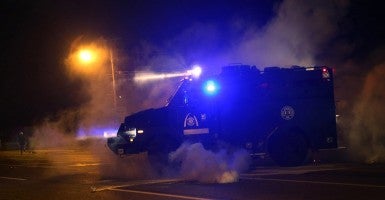For years, the federal government has been providing surplus military equipment to local law enforcement through the 1033 Program.
Since its inception in 1997, the program has delivered $5.1 billion in weapons, Humvees, 30-ton Mine-Resistant Ambush Protected vehicles and even helicopters and drones to cities and towns across the country.
The pace of the military equipment dispersal has quickened with the winding down of the U.S. military presence in Afghanistan and Iraq.
>>> Overmilitarization: Why Law Enforcement Needs to Scale Down Its Use of Military Hardware and Tactics
In 2013 alone, the 1033 Program transferred more than $449 million in equipment, weapons and vehicles to local law enforcement.
A military program provides surplus vehicles, weapons and even aircraft to local police.
“The only cost we incurred was the gas it took to drive it back,” the police chief in Ruidoso, N.M.—population 8,005—said earlier this year of the practically mint-condition MRAP his department picked up in Sealy, Texas. “The cost was zero dollars.”
This phenomenon is taking place big cities and small towns across America. One of the smallest, Preston, Idaho, with a population of 5,000, has its own MRAP.
Nearly 20 communities in New Mexico and New Mexico State University’s campus police now have MRAPs. The police department in Hobbs was so proud it produced a 30-second commercial featuring the vehicle and its officers in military gear, weapons drawn, bursting through the door of a house.
>>> Ferguson Unrest and ‘Police Militarization’ Talk of Nation in Wake of Shooting
Police chiefs who have solicited excess military hardware insist it is helpful, especially in violent situations.
One such case happened in Mayin Los Lunas, N.M. The bullet-proof MRAP protected officers and the public from 70 rounds fired by a suspect barricaded in a house, Police Chief Naithan Gurule said.
The wholesale rioting and chaos in Ferguson, Mo., was potentially far more deadly. However, it also prompted some Americans, including Sen. Rand Paul, to voice concern about the role of local police.
“The militarization of our law enforcement is due to an unprecedented expansion of government power in this realm,” the Kentucky Republican wrote in Time. “It is one thing for federal officials to work in conjunction with local authorities to reduce or solve crime. It is quite another for them to subsidize it.”




























